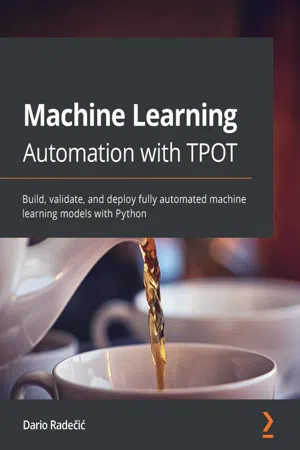
Machine Learning Automation with TPOT
Dario Radecic
- 270 Seiten
- English
- ePUB (handyfreundlich)
- Über iOS und Android verfügbar
Machine Learning Automation with TPOT
Dario Radecic
Über dieses Buch
Discover how TPOT can be used to handle automation in machine learning and explore the different types of tasks that TPOT can automateKey Features• Understand parallelism and how to achieve it in Python.• Learn how to use neurons, layers, and activation functions and structure an artificial neural network.• Tune TPOT models to ensure optimum performance on previously unseen data.Book DescriptionThe automation of machine learning tasks allows developers more time to focus on the usability and reactivity of the software powered by machine learning models. TPOT is a Python automated machine learning tool used for optimizing machine learning pipelines using genetic programming. Automating machine learning with TPOT enables individuals and companies to develop production-ready machine learning models cheaper and faster than with traditional methods. With this practical guide to AutoML, developers working with Python on machine learning tasks will be able to put their knowledge to work and become productive quickly. You'll adopt a hands-on approach to learning the implementation of AutoML and associated methodologies. Complete with step-by-step explanations of essential concepts, practical examples, and self-assessment questions, this book will show you how to build automated classification and regression models and compare their performance to custom-built models. As you advance, you'll also develop state-of-the-art models using only a couple of lines of code and see how those models outperform all of your previous models on the same datasets. By the end of this book, you'll have gained the confidence to implement AutoML techniques in your organization on a production level. What you will learn• Get to grips with building automated machine learning models• Build classification and regression models with impressive accuracy in a short time• Develop neural network classifiers with AutoML techniques• Compare AutoML models with traditional, manually developed models on the same datasets• Create robust, production-ready models• Evaluate automated classification models based on metrics such as accuracy, recall, precision, and f1-score• Get hands-on with deployment using Flask-RESTful on localhostWho this book is forData scientists, data analysts, and software developers who are new to machine learning and want to use it in their applications will find this book useful. This book is also for business users looking to automate business tasks with machine learning. Working knowledge of the Python programming language and beginner-level understanding of machine learning are necessary to get started.
Häufig gestellte Fragen
Information
Section 1: Introducing Machine Learning and the Idea of Automation
- Chapter 1, Machine Learning and the Idea of Automation
Chapter 1: Machine Learning and the Idea of Automation
- Reviewing the history of machine learning
- Reviewing automation
- Applying automation to machine learning
- Automation options for Python
Technical requirements
Reviewing the history of machine learning
- Data
- Computing power
What is machine learning?
- Machine learning is an application of artificial intelligence (AI) that provides systems the ability to automatically learn and improve from experience without being explicitly programmed (What is Machine Learning? A Definition – Expert System, Expert System Team; May 6, 2020).
- Machine learning is the concept that a computer program can learn and adapt to new data without human intervention (Machine Learning – Investopedia, Frankenfield, J.; August 31, 2020).
- Machine learning is a field of computer science that aims to teach computers how to learn and act without being explicitly programmed (Machine Learning – DeepAI, Deep AI Team; May 17, 2020).
Inhaltsverzeichnis
- Machine Learning Automation with TPOT
- Contributors
- Preface
- Section 1: Introducing Machine Learning and the Idea of Automation
- Chapter 1: Machine Learning and the Idea of Automation
- Section 2: TPOT – Practical Classification and Regression
- Chapter 2: Deep Dive into TPOT
- Chapter 3: Exploring Regression with TPOT
- Chapter 4: Exploring Classification with TPOT
- Chapter 5: Parallel Training with TPOT and Dask
- Section 3: Advanced Examples and Neural Networks in TPOT
- Chapter 6: Getting Started with Deep Learning: Crash Course in Neural Networks
- Chapter 7: Neural Network Classifier with TPOT
- Chapter 8: TPOT Model Deployment
- Chapter 9: Using the Deployed TPOT Model in Production
- Other Books You May Enjoy